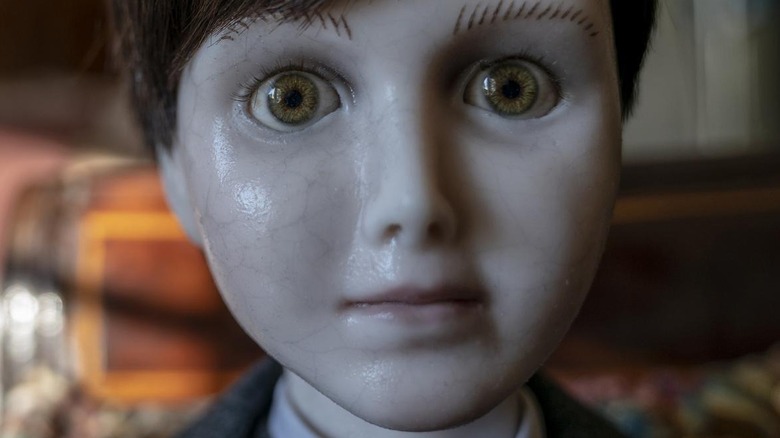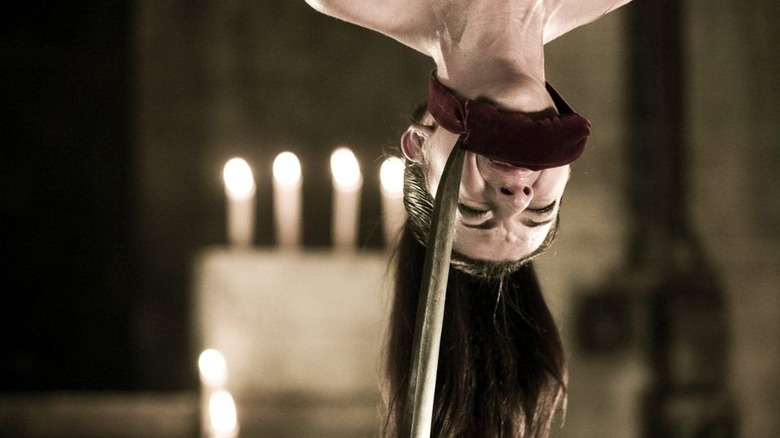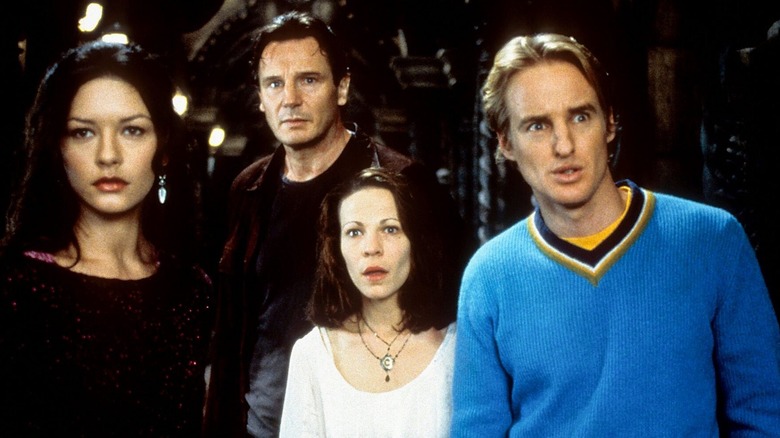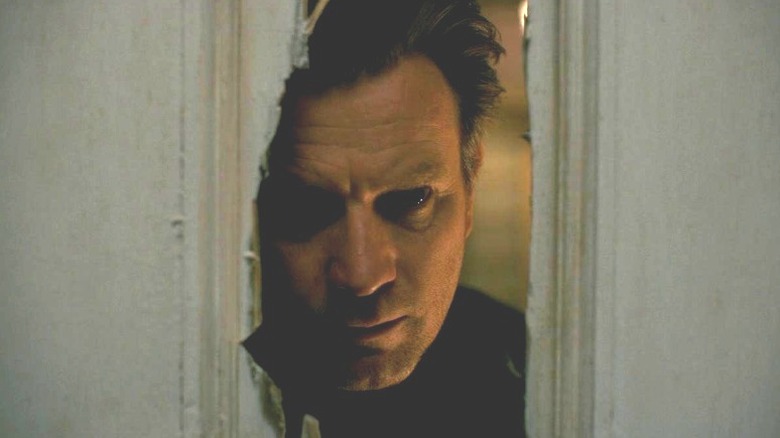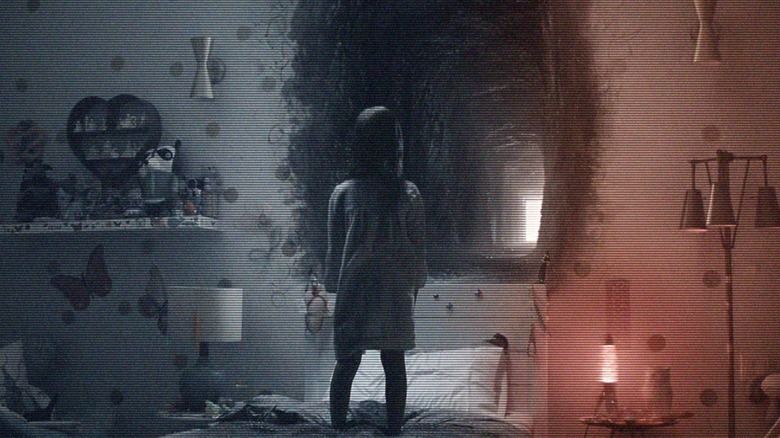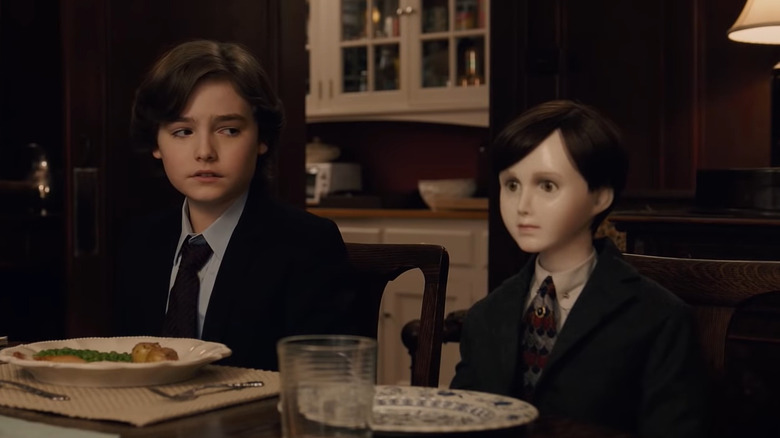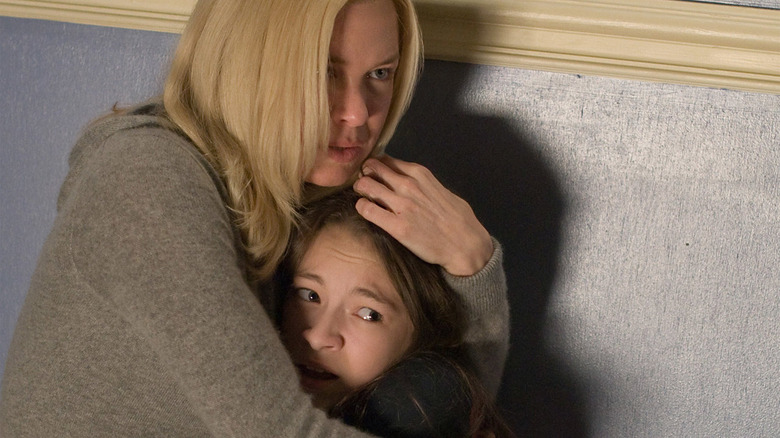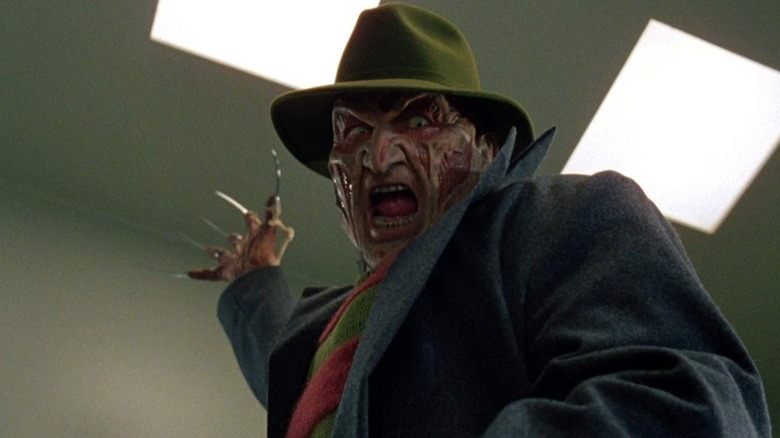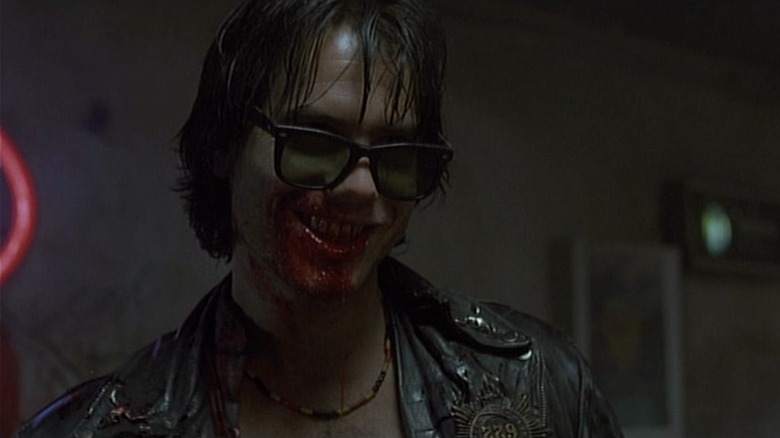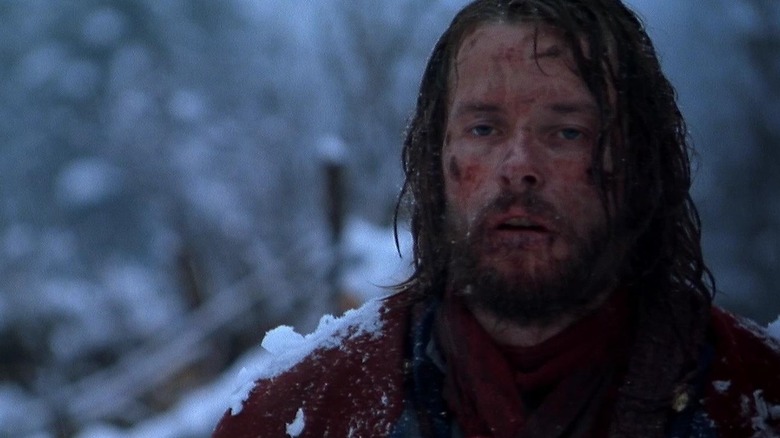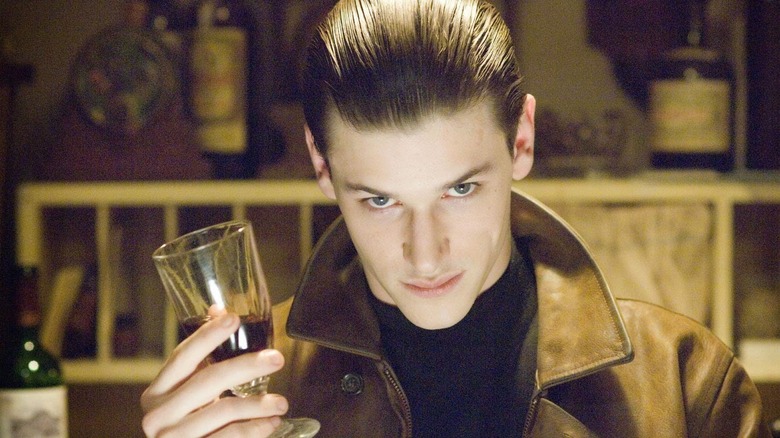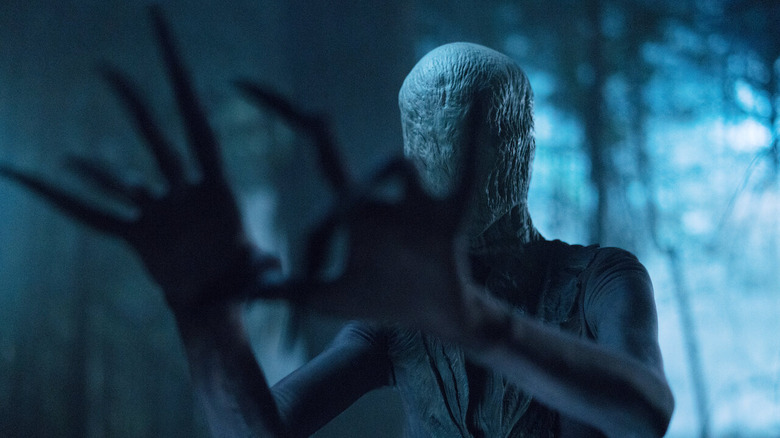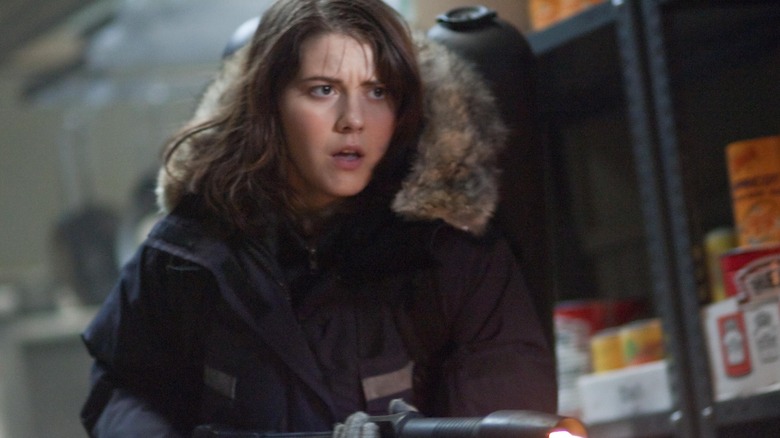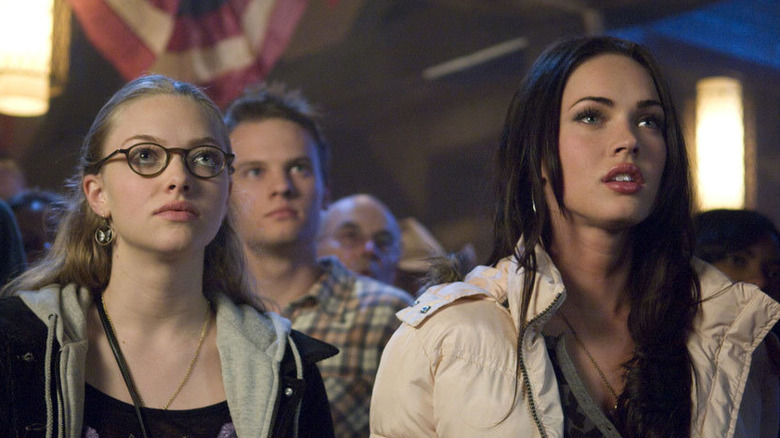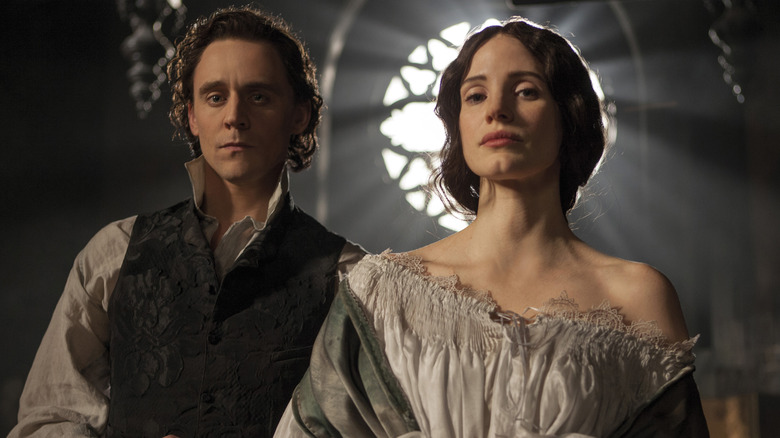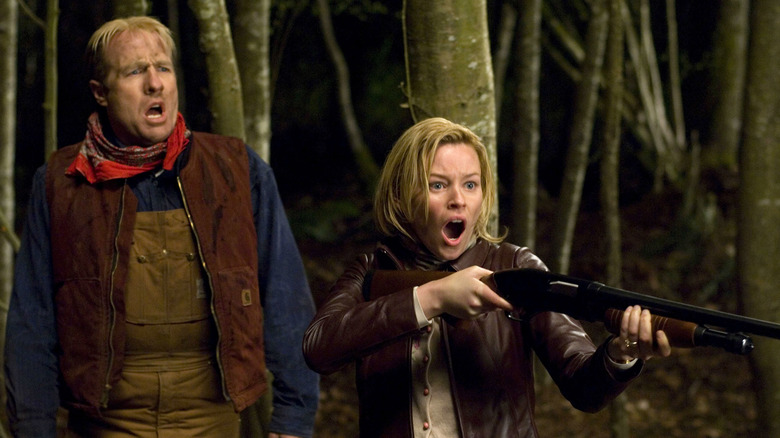The Real Reason These Horror Movies Flopped
In Hollywood, it's typical to perceive the horror movie as being foolproof at the box office. After all, so many of these films, including some of the most iconic entries in the genre, are made on such tiny budgets that it's almost impossible to not make a profit. That level of thriftiness defines modern-day horror outfits like Blumhouse Productions and other producers of scary movies. Few genres combine minimal financial investment and widespread appeal as well as horror films, but no genre is entirely golden at the box office and horror titles are no exception. Over the years, several high-profile horror features have ended up coming up gravely short at the box office and even outright lost money in some extreme instances.
Given how often even widely-reviled horror movies, like "The Devil Inside," somehow manage to make money, some extreme factors tend to inform the circumstances behind the rare horror film flop. Looking at the real reasons this assortment of frightening features fizzled, one finds elements like stale brand names or lazy marketing that are truly more unnerving than any ghost story could hope to be. Prepare to be chilled to the bone by the details that can end up slaughtering a horror movie's chances at box office success.
Hostel: Part II
Just before "Hostel: Part II" touched down in theaters in June 2007, a workprint copy of the feature leaked onto the internet. When the movie proceeded to take in just $33.6 million worldwide, a whopping 60% drop from the original movie's global intake, Roth blamed the financial shortcomings on that unforeseen piracy episode. While that event certainly couldn't have helped "Hostel: Part II," it's also not the only element that ensured this one was always going to struggle at the box office.
For one thing, the original "Hostel" was a hit, but not the sort of beloved horror movie that makes people crave a sequel. It was an early January movie that got a box office boost from being the only gruesome title in a marketplace dominated by award season fare and family movies. That competition for the first "Hostel" also highlights a problem "Hostel: Part II" faced: its release date. Dropping in the middle of the summer of 2007, this second "Hostel" title experienced way more competition than its predecessor, going up against "Ocean's Thirteen" and "Surf's Up." On top of all that, the marketing for "Hostel: Part II" failed to offer new elements that could intrigue moviegoers, while the trailers and posters just teased more grisly "Hostel" carnage. You need more than that to excel as a June release. With all these factors in play, it's clear piracy wasn't the only problem "Hostel: Part II" had to contend with.
The Haunting
Nobody involved in "The Haunting" could have imagined, when they were first putting the project together, that some other horror movie could surpass it. How could anything manage to overshadow an $80 million horror movie produced by Steven Spielberg and starring Liam Neeson, fresh off "Star Wars: Episode 1 – The Phantom Menace" earlier that summer? But there was a catch here: "The Haunting" opened in close proximity to "The Blair Witch Project" at the end of summer 1999, with the original, low-budget "found footage" faux-doc vastly surpassing the box office intake of the costly remake.
Grossing just $180.1 million worldwide, "The Haunting" was expected to earn much more with all of its big-name actors and a familiar brand name. Unforeseen bad timing wasn't the only issue "The Haunting" had to face. It also stood out like a sore thumb in the late 1990s horror landscape, which was based on fresh takes on the genre through titles like "Scream." In hindsight, "The Haunting" was ahead of the mid-2000s obsession with horror remakes like 2003's "The Texas Chainsaw Massacre" and 2004's "Dawn of the Dead." At the time, though, "The Haunting" was a box office disappointment whose shortcomings were made extra apparent by the concurrent surprise success of "The Blair Witch Project."
Doctor Sleep
On the surface, "Doctor Sleep" seemed to have everything going for it. It was a sequel to the iconic horror film "The Shining," it had a big-name actor (Ewan McGregor) in the lead role, and it was opening over the Veteran's Day holiday weekend. Surely a marketplace that seems to always respond to nostalgia-driven sequels, especially horror ones, would turn out in droves for "Doctor Sleep." Instead, this Mike Flanagan directorial effort became a surprise box office nonstarter and grossed just $71.8 million worldwide on a $45 million budget.
Part of the problem here was that without "The Shining" in the title, "Doctor Sleep" had an uphill battle convincing people that it was actually a sequel to that Stanley Kubrick horror classic. In the end, the marketing ended up getting caught between a rock and a hard place, with too many ads relying solely on callbacks to the original, which made it look derivative, while the title itself never made it apparent to viewers that this continued the story and world of "The Shining." It didn't help that this was an artsier kind of horror movie, with a slower pace and scares derived from an eerie atmosphere rather than just cheap jump scares. Those qualities ensured that "Doctor Sleep" was well-received enough to not come off as a cash grab critically, but they also ensured that audiences on the fence had further reason to stay away.
Paranormal Activity: The Ghost Dimension
With "Paranormal Activity 4," the "Paranormal Activity" franchise saw its box office clout abruptly shrink dramatically. A series that had cleared $100 million domestically with ease one year prior with "Paranormal Activity 3" now barely collected $50 million in North America. The ultra-cheap price tags on these movies ensured that this was still a profitable venture for Paramount Pictures, but it was also clear the sheen was wearing off and audiences were possibly growing sick of "Paranormal Activity" movies. So it's no surprise the temporarily "final" installment, "Paranormal Activity: The Ghost Dimension," brought further box office lows to the series.
"The Ghost Dimension" grossed $18.3 million in North America, not only the lowest domestic haul of any entry in the series but also smaller than the opening weekend sums of all prior "Paranormal Activity" installments. That abnormally minuscule take can be attributed to Paramount Pictures engaging in a quicker-than-usual home video release strategy that alienated enough theater chains to ensure that "The Ghost Dimension" could play in only 1,656 domestic multiplexes. Overseas grosses would take "The Ghost Dimension" to a $77.9 million worldwide total, enough to ensure Paramount didn't lose money on the $10 million feature. But this global gross was a far cry from what the "Paranormal Activity" movies had brought in just a few years earlier and made "Paranormal Activity 4" look like a barnburner by comparison.
Blair Witch
"The Blair Witch Project" was such a gargantuan box office success in 1999 that it seemed like a foregone conclusion that it would spawn several lucrative sequels, like later microbudget horror success stories such as "Saw" or "Paranormal Activity." However, attempts to turn "Blair Witch" into a franchise have repeatedly hit a brick wall. This was even true for the 2016 film "Blair Witch," which attempted to mine potential nostalgia for the original movie into a relaunched, ongoing franchise.
Unfortunately, that never happened. Sites like Pro Box Office originally predicted that "Blair Witch" would have a $20 million+ domestic debut, but it ended up making even less than that in its entire North American run. Even accounting for all worldwide territories, "Blair Witch" still came up severely short at the box office with just a $38.7 million gross. A big problem for "Blair Witch" was the state of the found-footage horror movie circa 2016. A novel gimmick in 1999 when "The Blair Witch Project" was unleashed on the masses, audiences outright rejected mid-2010s found-footage horror titles like "Devil's Due." This subgenre had become a cliché rather than an exciting subversion and not even the return of the "Blair Witch" brand name could overcome that. Plus the marketing for "Blair Witch" didn't promise anything substantially new compared to the original, further cementing its eventual box office fate.
Brahms: The Boy II
It would be understandable for most moviegoers who saw the trailer for "Brahms: The Boy II" to respond not by shrieking in terror, but by getting puzzled and asking, "Was there a first one?" Indeed there was an original "The Boy," though it was released in January 2016 to little fanfare. While not a flop, it also wasn't the kind of movie that generated enough enthusiasm to get people hankering for another installment. But rare is the mildly profitable horror movie that doesn't inspire a sequel, so "Brahms: The Boy II" dropped into theaters in February 2020.
Debuting in this timeframe meant that "Brahms: The Boy II" had only a few weeks to make money before the coronavirus (COVID-19) pandemic would totally upend the entire theatrical exhibition business. But even before that crisis took hold, "Brahms: The Boy II" was a box office nonstarter and only grossed $18.9 million globally on a $10 million budget. Not only was the original "The Boy" not beloved in its theatrical run, but it was also four years old by the time a sequel arrived, an eternity when it comes to horror movie installments. Any potential revenue to be soaked up through brand-name recognition was long gone by this point, leaving an inexplicable sequel nobody asked for.
Case 39
"Case 39" started filming back in 2006, and under normal conditions, it would have been ready to go for either a 2007 or 2008 release. However, this horror film wouldn't find its way to movie theaters until October 2010, despite being headlined by actors like Renee Zellweger and Bradley Cooper. What happened here? Just a month before its debut, Entertainment Weekly did an extensive rundown on its troubled history, with Paramount Pictures giving it two separate dates in 2008 and 2009 before leaving it undated for over a year. The director, Christian Alvart, attributed this to the film being a smaller-scale affair that Paramount didn't see as a priority to release.
Whatever the reason for its constant delays, all the rescheduling and then the abrupt release in October 2010 did not signal an enormous amount of confidence from Paramount. With only a minimal promotional push, the title grossed just $28.7 million globally on a $21 million budget. Part of the problem here wasn't just the marketing, but also the release date. October 2010 was full of horror movies, including "Saw 3D" and "Paranormal Activity 2," with "Case 39" opening directly against the Matt Reeves vampire film "Let Me In." Opening a film with so little buzz against so many other scary films just cemented the fate of "Case 39" at the box office.
Wes Craven's New Nightmare
Every horror franchise has its financial low point at the box office. For the "Nightmare on Elm Street" series, this nadir came from "Wes Craven's New Nightmare," which topped out at $18 million globally. Director Wes Craven attempted something fresh with "New Nightmare," right down to delivering a new version of Freddy Krueger and attempting to deliver a meta-narrative involving the filming of a new "Nightmare on Elm Street" movie. But sites like ScreenRant have speculated that the underwhelming box office was due to the film's premise being impenetrable to mainstream audiences.
Other factors may have included a minimal marketing budget and competition from "Pulp Fiction." It also can't be ignored that in 1994, Freddy Krueger was not in his prime critically. The most recent "Nightmare on Elm Street" movies had garnered negative reviews and transformed Krueger from an intimidating foe into a predictable punchline. Even with "New Nightmare" promising something different, audiences just weren't psyched for further entries in this franchise. Given just how many issues were attached to "Wes Craven's New Nightmare," it's honestly a wonder that it managed to make the meager amount that it did globally.
Near Dark
Today, "Near Dark" is a cult classic that's garnered acclaim from film critics for its subversion of typical gender norms in Westerns as well as widespread praise for a gusto supporting performance from Bill Paxton. Though not a household name of a movie, "Near Dark" has proven enduringly popular enough to make it seem odd that the film wasn't just a box office dud in its original theatrical release, but barely even got released into theaters.
Kathryn Bigelow's 1987 take on vampires only grossed $3.3 million domestically, with no recorded international box office figures to speak of. That was nowhere near enough to cover its $5 million budget, but the problems were not on "Near Dark" itself. Instead, the faults lie with the movie's distributor, which put "Near Dark" out in only 262 theaters. For comparison's sake, the original "Hellraiser" that same year managed to play in 1,104 locations. With no real opportunities for moviegoers to actually go out and watch "Near Dark" on the big screen, how could this movie ever have a chance to be profitable?
Ravenous
Genre mashups are frequently a tough sell to audiences. Even horror-comedies have often struggled financially, let alone more complex mixtures like sci-fi/Westerns. Thus it shouldn't be a shock that the Western horror film "Ravenous," which also threw cannibalism into the mix for further subversive disruption, did not set the box office alight with success. This unusual horror title grossed just $2 million in its box office run.
Adding to the hurdles inherent in tackling a genre mash-up was that "Ravenous" was only released in 1,040 locations while the film also had no big names in its cast. The website Gothic Western also pointed out that "Ravenous" was an odd fit for a wide theatrical release and likely would have fared better years later, with more fluid release models that deliver oddball titles to niche audiences with greater ease. Of course, the saga of "Ravenous" does not begin and end with its box office run. Like many horror movies that stumbled at the box office, "Ravenous" has managed to ride a second wave of life on home video.
Hannibal Rising
Everybody loves Anthony Hopkins' portrayal of Hannibal Lecter. While other actors like Brian Cox and Mads Mikkelsen have delivered unique and beloved portrayals of this fictional cannibal, when it comes to big-screen versions of the character, audiences think of the British actor's Oscar-winning performance. This proved a problem for the 2007 film "Hannibal Rising," the first feature film adaptation of the character in over two decades that attempted to deliver a Hannibal Lecter movie without Hopkins.
This prequel explored a younger version of Lecter played by Gaspard Ulliel. It's easy to see why producers saw dollar signs at the prospect of making a new movie with the valuable Lecter character that didn't require handing over a hefty paycheck to Hopkins. But the doctor just wasn't as appealing to mass audiences without Hopkins on board. Plus there wasn't any demand from even die-hard Lecter fans to explore his backstory. With "Hannibal Rising" coming on the heels of two other Lecter movies in the six preceding years, moviegoers had had their fill and a prequel without Hopkins wasn't going to inspire them to return. "Hannibal Rising" grossed just $80.5 million globally, the lowest-grossing worldwide sum for a Hannibal Lecter movie since 1986.
Slender Man
There were a lot of problems facing the 2018 feature film "Slender Man." Chief among these was the gruesome fact that the movie was coming on the heels of a tragedy in Wisconsin where two teenage girls attempted to murder a friend because of the perceived influence of Slender Man. The mere existence of the film "Slender Man" prompted controversy, but that wasn't the only problem. There was also the fact that, in 2018, "Slender Man" was coming out way too late to properly capitalize on the initial popularity of its titular monster.
Then there was its reported $28 million price tag, which meant that "Slender Man" cost just $7 million less than the significantly more high-profile movie "It" from 2017. On top of everything else, the producers of "Slender Man" clashed with its studio, Sony, over the film's marketing, leading the latter to consider selling the film to a streaming service. With all this, it was no surprise that "Slender Man" ended up wiping out at the box office with just $51.9 million globally, less than double its budget. That put "Slender Man" behind the worldwide grosses of noticeably cheaper 2018 horror titles like "Hereditary" and "Truth or Dare." Some movies manage to outrun their problematic pasts, but others, like "Slender Man," end up consumed by them.
The Thing (2011)
John Carpenter's 1982 classic "The Thing" has enjoyed a revival in recent years, with fans coming to see it as one of the best horror movies ever made. Despite this newfound love, the movie didn't do very well at the box office upon release while also being panned by contemporary critics quick to bash the film's over-the-top gore and slow pacing. Since it was going up against other sci-fi giants such as "Blade Runner" and "E.T the Extraterrestrial," it's not much of a surprise that a slow burn like "The Thing" got outmatched. Yet, it may come as a surprise to learn that the 2011 prequel of the same name did even worse.
2011's "The Thing" was directed by Matthijs van Heijningen Jr., and featured an impressive international cast of actors including Mary Elizabeth Winstead, Kristofer Hivju, Joel Edgerton, and Adewale Akinnuoye-Agbaje as researchers at a Norwegian Antarctic outpost who discover a shapeshifting alien. Despite high expectations by Universal Pictures, "The Thing" proved to me a massive box office bomb by only making $31 million on a $38 million budget. According to a weekend report from the time by BoxOfficeMojo, the film failed to find new audiences thanks to older fans' disinterest in a remake at all. The site reported, "There was a pervasive cynicism about the need for a remake within this community, though, and with an identical story, location, and title, there didn't appear to be much of a reason to head to theaters." It also didn't help that the production team infamously ditched all their practical effects in favor of subpar CGI, which was a crucial element of what fans like about John Carpenter's version.
Jennifer's Body
Unique on this list is "Jennifer's Body," the 2009 horror-slasher-comedy directed by Karyn Kusama and written by Diablo Cody about a high school girl who's possessed by a demon to only kill boys. This film stars Megan Fox and Amanda Seyfried with a supporting cast including Adam Brody, J.K. Simmons, Amy Sedaris, and Chris Pratt. "Jennifer's Body" has gained significant reappraisal within the past few years as a satirical and self-aware piece of feminist filmmaking which also has gained a place in the pantheon of both queer and bisexual cinema.
According to a Vox interview with writer Diablo Cody, she noted how the marketing team behind "Jennifer's Body" didn't do her screenplay any favor, claiming, "The movie was marketed all wrong. I'm not usually an argumentative person. In fact, I'm really passive. But that was like the one time I've gotten in a fight because I was so furious." While the film did actually get a notable female-leaning audience (which was their intention), the marketing issues were enough to cause "Jennifer's Body" to be a box office disappointment with only about $6.8 million made during its opening weekend.
Crimson Peak
Guillermo del Toro's 2015 horror romance "Crimson Peak" had everything going for it. The film boasted an award-winning director, intriguing setting, and a stacked cast of Hollywood talent including Tom Hiddleston and Jessica Chastain. It told the mysterious tale of a woman solving otherworldly clues in a spooky mansion seemingly haunted by ghosts of previous inhabitants.
Despite all this, "Crimson Peak" was a disappointing installment in Guillermo del Toro's otherwise successful filmography of hits like "Pan's Labyrinth," "Pacific Rim," and "The Shape of Water." Audiences were mostly uninterested in the genre-bending gothic flick since "Crimson Peak" did not perform well at the domestic box office, making only $31 million in the United States market. While the movie did make a profit in total with a $74 million worldwide haul it still remains seen as a major disappointment for a movie with such star power. According to Deadline, the film underperformed primarily due to it being up against bigger (and possibly better) movies. The site reported, "'Crimson Peak' suffered from a very competitive PG-13 adult market where such films as '[The] Martian' and 'Bridge of Spies' were overperforming."
Slither
"Slither" was one of director James Gunn's first big projects and, having come from the no-budget world of making Troma movies, it proved to be a major misstep in his early career. Although James Gunn is now best known for his stewardship of both the "Guardians of the Galaxy" franchise and his strong hand in overseeing the future of the DC Extended Universe with additions like "The Suicide Squad" and "Peacemaker," Gunn came from extremely humble beginnings making shlocky horror films.
One thing fans consistently seem to love about James Gunn is his sense of humor, which carries over into nearly all his films. "Slither" confused audiences at the time by mixing the genres of horror with black comedy and science fiction to make a strange story that many viewers struggled to wrap their head around. Gunn even commented on the failure of "Slither" back in 2006, telling The Hollywood Reporter that it was overwhelming for audiences. He said, "I think that because it was comedy-horror instead of pure horror is where the problem lay. It's the first comedy-horror in a long time, and maybe the marketplace just isn't ready for comedy-horror yet. It's difficult to think of other explanations."
